#Baron Voltage
Explore tagged Tumblr posts
Text
#lego racers#lego#n64#lego pirates#lego adventurers#lego space#lego insectoids#lego islanders#captain redbeard#king kahuka#basil the batlord#Johnny thunder#baron von baron#navigator sharp#polls#1990s
10 notes
·
View notes
Text
Posted Cards Master List - 42.0
December 2022, 1st thru 21st
Archfiend's Ghastly Glitch
Ariane the Labrynth Servant
Arianna the Labrynth Servant
Bearblocker
Book of Eclipse
Compulsory Evacuation Device
Cosmic Cyclone
Droll & Lock Bird
Duelist Alliance
Farewelcome Labrynth
Fiend Griefing
Geri the Runick Fangs
Hojo the Vaylantz Warrior
Hugin the Runick Wings
Imperial Iron Wall
Invader of Darkness
Labrynth Archfiend
Labrynth Barrage
Labrynth Chandraglier
Labrynth Cooclock
Labrynth Labyrinth
Labrynth Set-Up
Labrynth Stovie Torbie
Lovely Labrynth of the Silver Castle
Mamaonaka the Vaylantz United
Munin the Runick Wings
Nazuki the Vaylantz Ninja
Pendulum Fusion
Pendulum Switch
Quick Booster
Reckless Greed
Runick Allure
Runick Destruction
Runick Dispelling
Runick Flashing Fire
Runick Fountain
Runick Freezing Curses
Runick Golden Droplet
Runick Slumber
Runick Smiting Storm
Runick Tip
Saion the Vaylantz Archer
Senet Switch
Shinonome the Vaylantz Priestess
Trap Trick
Vaylantz Buster Baron
Vaylantz Dominator Duke
Vaylantz Genesis Grand Duke
Vaylantz Mad Marquess
Vaylantz Voltage Viscount
Vaylantz Wars - The Place of Beginning
Vaylantz World - Konig Wissen
Vaylantz World - Shinro Bansho
Welcome Labrynth
Albaz the Ashen
Amaze Attraction Thrill Train
Ashura King
Askaan, the Bicorned Ghoti
Aussa the Earth Channeler
Branded Expulsion
Branded in Central Dogmatika
Brilliant Rose
Cartorhyn the Hidden Gem of the Seafront
Cross Keeper
Destiny HERO - Destroyer Phoenix Enforcer
Digit Jamming
Double Dust Tornado Twins
Draco-Utopian Aura
Eanoc, Sentry of the Ghoti
Eka the Flame Buddy
Elemental HERO Shining Neos Wingman
Elemental HERO Spirit of Neos
Emperor Tanuki's Critter Count
EN Wave
Exosister Martha
Exosister Returnia
Favorite Contact
Gadget Gamer
Garura, Wings of Resonant Life
Gem-Knight Lady Rose Diamond
Gem-Knight Quartz
Ghoti Chain
Ghoti of the Deep Beyond
Gigantic Spright
Grandtusk Dragon
Gunkan Suship Shari Red
Hydralander Orbit
Icejade Creation Aegirocassis
Instant Contact
Krawler Soma
Kurikara Divincarnate
Life Extreme
Mathmech Circular
Melffy Pinny
Melffy Staring Contest
Melffy Wally
Merry Melffys
Mimesis Elephant
Mokey Mokey Adrift
Moray of Avarice
3 notes
·
View notes
Text
Aloft Inktober/Glocktober 2023 Ask Request
The month is almost up and I haven't been doing a daily creative thing, so I'm bringing back my old #glocktober project, lightning round style. Send me asks with names pulled from my notebook Twitter account The New Belligerence and I'll provide descriptions for them in my post-apocalyptic science fantasy with airships TTRPG setting, Aloft: A Post-Atomic Romance (formerly Sons & Daughters). Keep em coming, and hopefully I'll get to 31 by All Saints Day.
Doing it on Tumblr instead of Twitter this year because Twitter engagement is at an all-time low, and the latest Horrors have left the space feeling like it's more for observation of said Horrors, and less welcome to concurrent, unrelated creativity.
Examples from previous years:
Hard No: A stop sign shield reinforced with kevlar, fiberglass, and bicycle aluminum, carried by Alex Webster, a crew chief with the vigilante infrastructure organization calling itself the US Department of Transportation. They use it to bash more often than to block.
The Gray Lady is both an airship crewed by journalists and equipped with an onboard printing press, and the name of the paper they distribute across the continent. It's one of the only independent airships declared off-limits to pirates sponsored by the Great Lakes barons.
Heroic Measures: This electrified falchion is wielded by the Twin Cities' infamous android paramedic-turned-monster hunter, Doctor Musashi. Its voltage generating components were adapted from a manual external defibrillator.
Send in the asks and help me get some creative flex sets and reps in.
#glocktober#glocktober 2023#inktober#inktober 2023#ttrpg#dnd#writing prompt#the new belligerence#aloft#sons & daughters#reblogs appreciated
8 notes
·
View notes
Text
Shockingly Good Strategies for High Voltage Mode in Marvel Snap

If you’re like me, you live for those moments when a game mode drops that not only shakes things up but also offers you a chance to play without the looming threat of losing everything. Enter Marvel Snap’s High Voltage Mode, a limited-time event that’s all about fast-paced fun. Released on October 17, 2023, and running until October 24, this mode invites players to experience the adrenaline rush of quick matches without the baggage of high stakes. Let's dive into the electrifying details!

What Is High Voltage Mode?
High Voltage Mode is all about speed, strategy, and surprises. Unlike its predecessor, Deadpool’s Diner, which focused on ticket systems and stakes, this new mode encourages players to unleash their competitive spirits without fear of penalties for losses. If you win, you snag some cool rewards, but if you lose? Well, nothing happens! No losses, just pure fun. And who doesn’t love that? Matches in this mode last around 1 to 2 minutes and feature three rounds where players draw two cards each turn instead of one. The unique twist? You can't Snap, and an Arc Reactor replaces the Snap button, randomly distributing 2 to 5 Energy points at the start of each round. The more you play, the more the Energy stacks up, allowing for some thrilling strategies.

Shockingly Good Strategies for High Voltage Mode in Marvel Snap (2) Gameplay Mechanics: What Makes It Unique? Each round kicks off with a random number of Energy points, making every match unpredictable and exciting. The Arc Reactor guarantees a build-up of Energy, so if you’re good at managing your resources, you can create some wild plays. But be cautious! This isn’t a mode for the faint-hearted, as the randomness (or RNG, as the cool kids say) can lead to unexpected results. Here’s a quick breakdown of the energy mechanics for each round: - Round One: 2 to 5 Energy - Round Two: 4 to 10 Energy - Round Three: 6 to 15 Energy In simpler terms, this is the game equivalent of giving a kid a candy store to run wild in—exciting, chaotic, and a little unpredictable!

Shockingly Good Strategies for High Voltage Mode in Marvel Snap (5)

Shockingly Good Strategies for High Voltage Mode in Marvel Snap (4) Top Deck Strategies With so many variables in High Voltage, identifying the best deck can feel like trying to catch smoke with your bare hands. However, players have found success with Zoo and Hela decks. If you’re looking to dominate, consider the Hulking deck featuring cards like Blob, Alioth, Skaar, and Baron Zemo. Trust me, these bad boys pack a punch. Some of the standout cards that players are flocking to in this mode include: - Hulkling: Perfect for leveraging the mode’s RNG. - Blob: A beast that capitalizes on card synergies. - Alioth: Great for disrupting your opponent's final strategies. - Super Skrull: A card that can morph into whatever you need for that particular game. Card Restrictions: The No-Go Zone Of course, with great power comes great responsibility—or, in this case, great bans. To keep the gameplay fair and prevent game-breaking combos, Galactus, Magik, and Black Widow are banned. These cards could easily undermine the fast-paced nature of High Voltage, and we all know that a long game just isn’t the point here. https://www.youtube.com/watch?v=r70ib5Z8Xjg Unlocking Agony: The Quest for Volts As if all this action wasn’t enough, there’s also a new card to unlock—Agony. It requires 11,000 Volts, which sounds like a lot, but don’t panic! Winning matches nets you a measly 20 Volts. However, by completing daily event missions, you can rack up to 2,475 Volts a day. So, if you start grinding early in the event, you could have Agony unlocked in about six days. But let’s face it, nobody wants to wait that long. You can always use Gold to refill those daily missions if you’re feeling impatient. Should High Voltage Become a Permanent Fixture? As a self-proclaimed aficionado of Marvel Snap, I can’t help but wonder why Second Dinner dangles these fun, engaging modes in front of us only to snatch them away after a week. Why not let High Voltage become a staple? It offers more excitement than regular matches, blending risk-free gameplay with the thrill of fast-paced strategy. Imagine the possibilities if this mode were to stick around permanently! Marvel Snap’s High Voltage mode is a refreshing breath of fresh air in the ever-evolving landscape of card games. With its no-stakes gameplay and the chance for quick matches, it’s a great way to dive into the Marvel universe without the weight of failure hanging over your head. And who doesn’t want a little more fun in their gaming life? For those who want to delve deeper into Marvel Snap and its various modes, check out Marvel Snap's Official Blog and GameSpot's Coverage for the latest updates and strategies. These sites offer a wealth of information to enhance your gameplay experience! Read the full article
0 notes
Text
The Colpitts oscillator experiment and DIY FM transmitter
The awesome Colpitts oscillator. Exploring the secrets of the Colpitts generator.

Hello, and welcome to our electronic studies! We probably all know that an oscillating circuit consists of a capacitor (C) and an inductor (L), and its waveform is an ideal sine wave.
In the LC resonant circuit, single-frequency oscillations occur, and their period in seconds is equal to 2π√(LC).

This equation is called Thomson's formula after its author, William Thomson, aka 1st Baron Kelvin. Many other things are named after him because Lord Kelvin was an outstanding scientist and inventor. One can recall, for example, the Kelvin, a unit of absolute temperature, or the marine compass with sundial he invented.

Another thing we know is that a transistor and an operational amplifier amplify the signal, meaning they transform a sin wave with a small amplitude into a sine wave with a bigger amplitude. We had 0.5 volts; it became five volts - ten times as much.

However, real electronic devices, even seemingly simple ones made from a handful of components, work in a much more complex and interesting way than the simplified idea of them from a school physics class.
This can either cause problems that we must learn to overcome or inspire technical creativity and help us achieve difficult tasks with simple components.
Today, we will study the operation of a real Colpitts oscillator, and a small printed circuit board and a digital oscilloscope will help us with this.
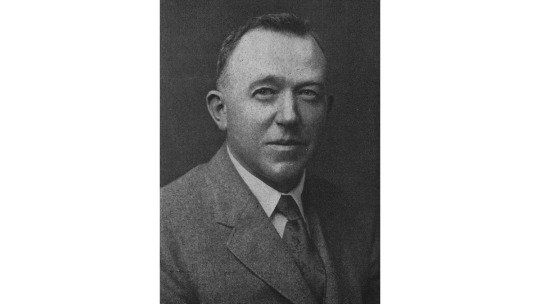
Edwin Henry Colpitts was a great inventor and a famous communications engineer. From 1897 to 1899, he served at Harvard's Jefferson Physical Laboratory. From 1899 on, Mr. Colpitts worked at the American Bell Telephone Company. In 1907, he became the research branch chief at the Western Electric Company. It was a manufacturing division of the American Telephone and Telegraph Company from 1881 to 1995.

Colpitz became vice president of AT&T in 1924 and was vice president of Bell Labs from 1934 to 1937. From 1940 to 1946, he served as head of technical aid for Division 6 (antisubmarine warfare) of the National Defense Research Committee and was awarded the Medal of Merit.
As often happens among renowned geniuses, Colpitz neglected his most known invention. He described the operating principle of his generator in a private conversation around 1915. He quickly forgot this product pitch, and later, according to company practice, he was asked to sign a patent application in 1918 (US patent 1624537).
A distinctive feature of the Colpitts oscillator is that the positive feedback for the amplifier (which can be a bipolar or field-effect transistor, an operational amplifier, or a vacuum tube) is received from a voltage divider on two capacitors connected in series and connected to an inductor.
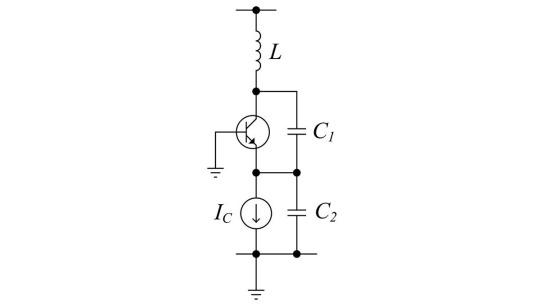
The oscillation frequency is nearly equal to the resonant frequency of the LC circuit of two capacitors with an inductor parallel to them.

The actual frequency will differ from the theoretically calculated one due to the distribution of capacitances and the resistive load of the transistor. This is exactly what we will see on the oscilloscope screen.

The twin brother and probable predecessor of the Colpitts generator was the Hartley oscillator; a patent application for it was filed in 1915 (US patent 1356763, issued 1920). The difference is that a voltage divider for positive feedback is formed not by two capacitors but by two inductors in series or a single-tapped inductor.
The innovative feature behind the Hartley oscillator was that its coils did not have to be magnetically coupled, which was strictly necessary for its predecessors, the Meissner and the Armstrong oscillators.
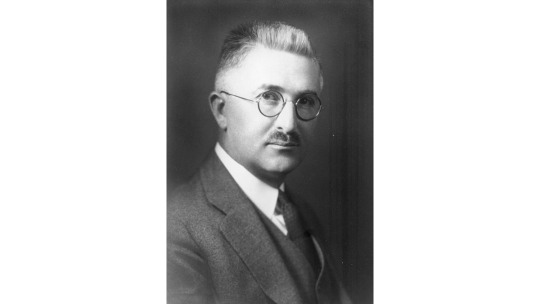
Rhodes Scholarship winner Ralph Vinton Lyon Hartley, also known for pioneering the concept of "information" as a random variable and for attempting to define the "unit of measure of information", has worked for the Western Electric Company since 1915. He was in touch with Edwin Colpitts at the time and probably was a part of the aforementioned discussion on using a capacitive voltage divider instead of an inductive one.
Hartley was awarded the IRE (now IEEE) Medal of Honor for his generator and information proportionality law in 1946. In addition to the oscillator, Hartley transform, and the logarithmic unit of measure for information entropy named after him, he owns more than 70 patents, including a neutralization circuit to eliminate parasitic self-excitation of a triode.

The very first IRE Medal of Honor in history was received by the inventor of the LC continuous oscillation generator with positive feedback (differing from the earlier shock excitation of damped oscillations, like the Hertz generator and Tesla spark transformer).

The idea of positive feedback was also introduced by American electrical engineer and innovator Edwin Howard Armstrong, inventor of the FM radio, superheterodyne and super-regenerative radio receivers, and FM radar. In total, Armstrong filed 42 patents.

The Armstrong oscillator, made in 1912, was an LC resonant tank circuit connected to the input of a tube or transistor amplifier stage. A feedback coil was connected to the output of the cascade.

The generator, invented in 1913 and named after Austrian engineer and physicist Alexander Meissner, was similar to the Armstrong generator; the only difference was that the Meissner LC generator circuit was connected to the output of the amplifier. The coupling coil was connected to the input. These two oscillators were so close that they are now often combined under the general name "Armstrong-Meissner oscillator".
Each of these generators must be carefully tuned to produce a clean sine-wave signal. We will now see this during the experiment. An oscilloscope can show more than a dozen formulas.
In today's experiment, we will make use of a board designed for a middle school experiment. It contains a Colpitts oscillator on transistor Q1, an amplifier stage on transistor Q2, a reversed-phase amplifier on op-amp U1A, and a node on operational amplifier U1B, which can be a comparator or an analog signal amplifier, depending on the setting.
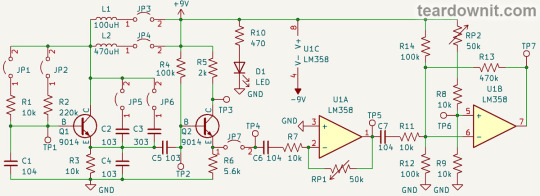
The operational amplifiers are powered by a bipolar ±9-volt power supply. At the same time, the transistor stages only need a unipolar + 9 volts of power.
DC isolation is provided by capacitors C5, C6, and C7, which pass the alternating component and block the direct current one. This way, it is possible to transmit an alternating electrical signal between circuit points with different potentials. This is one of the fundamentals of electronic circuitry.
Capacitor C1 grounds the AC base of transistor Q1, so the cascade operates in common-base mode. Resistor R1 (or R2, we can switch between them using jumpers JP1 and JP2) sets the bias current of the base of the transistor and thus its operating point.
The oscillating circuit coils are switched by jumpers JP3 and JP4, capacitors C2 and C3 by JP5 and JP6.
In total, we have two to the power of three, that is, eight options for jumper positions. Let's start from the very first: close JP1, JP3, and JP5. Next, we will switch one jumper at a time to see the changes at each stage until we've tested all eight possible combinations.
Let's take another look at the formula for the oscillation frequency of the Colpitts generator. The calculated oscillation period is 2π√(0.1 mH * 5 nF) = 4.44 ns. This corresponds to a frequency of 225 kHz.

Inductance L2 exceeds L1 by 4.7 times, which should reduce the frequency by √4.7 = 2.17 times. The capacitance of C3 is 3 times higher than that of C2, so we should expect a decrease in frequency by √(0.75/0.5) = 1.22 times.

Let's connect the oscilloscope to the node TP2 output of the generator. The measured frequency when C = 0.01 uF and L = 100 uH turned out to be 314 kHz; the calculated frequency is 30% lower. The cause could be Chinese-made ceramic disk capacitors; cheap ones tend to have 30–35% less capacity than listed. The oscillation amplitude Vp-p is 3.92 V, while the sinusoid is not ideal with a flattened lower part.

We did not replace either capacitor or inductor; we just switched the transistor base bias resistor from 10 to 220 kOhm. Now we have a beautiful sine wave with an amplitude of 4.44 V. And the most interesting thing here is that the frequency has decreased to 301 kHz.
The fact is that the base bias current changes the conductivity of the transistor and, accordingly, the equivalent capacitance, which defines the resonant frequency of the oscillatory circuit. This property of a transistor LC oscillator will help us build a simple FM radio transmitter.

After connecting a 0.03 uF capacitor, the oscillation frequency dropped by 20% to 243 kHz, which fully correlates with the calculations. The amplitude has dropped to 2.6 V. The waveform is distorted; the sine wave is now modulated with a half-frequency signal. Each odd half-wave is twice the amplitude of the even one.

Switching back to the 10 kOhm resistor, we see the frequency increase to 263 kHz. The amplitude dropped even lower, to 2.28 V, but the sine wave is now flawless: symmetrical and not flattened at the bottom.
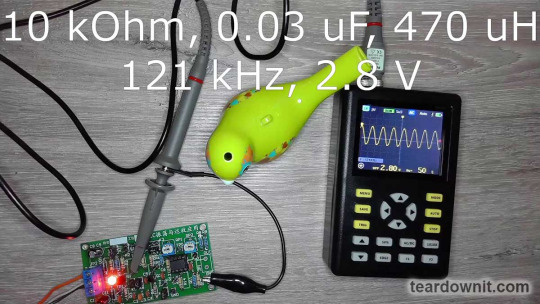
Connecting the 470 uH inductor, the amplitude is 2.28 V. The frequency of 121 kHz is exactly 2.17 times lower than 263, which fully corresponds to the formula.

With a 220 kOhm resistor, the frequency dropped to 54.3 kHz. The minus-first harmonic has now become stronger than the design frequency of the generator. So, we got the frequency divided in half, and the fundamental frequency now becomes the first harmonic. The amplitude increased greatly to 4.9 V.

With a 0.01 uF capacitor, the voltage increased to 7.28 V. The sine wave looks right, and the frequency is correct—133 kHz.

With a 10 kOhm resistor, the amplitude dropped to 4.52 V, and the frequency increased to 145 kHz. The lower part of the sine wave is squashed.
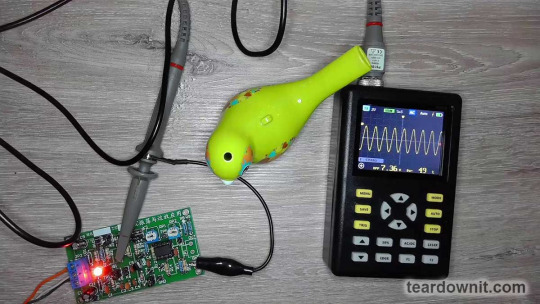
To look further into the signal propagation, let's revert to the 220 kΩ resistor because this combination produced a stable and strong signal with an ideal sine wave shape. Now, let's see the distortion caused by the transistor and operational amplifiers.

We see extreme distortion on collector Q2. Not only did full-wave rectification of the signal occur, but a third harmonic, characteristic of transistors, was also added. It shows up as a hump one-third of the period wide. Such odd transistor harmonics are undesirable for the resulting sound, unlike tube harmonics.
Such strong signal distortion is caused by the scheme with a common collector and not with a common collector. If we connected a capacitor in parallel with R6, we would get a common-emitter stage, and the signal at the collector would be much cleaner.
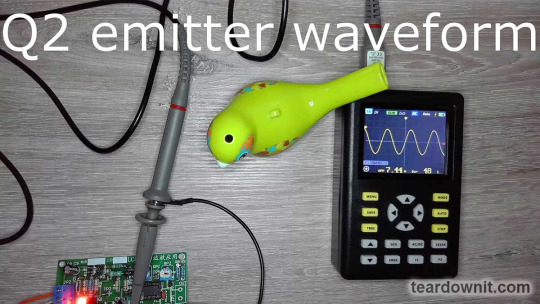
On the contrary, we see an excellent pure sine wave at the emitter because Q1 operates in buffer mode or emitter follower.

Now, let's connect the oscilloscope probe to the output of the first operational amplifier, U1A. And instead of a sinusoid, we see relaxation oscillations, the pattern of which changes depending on the resistance of the trimming resistor RP1 in the feedback loop.
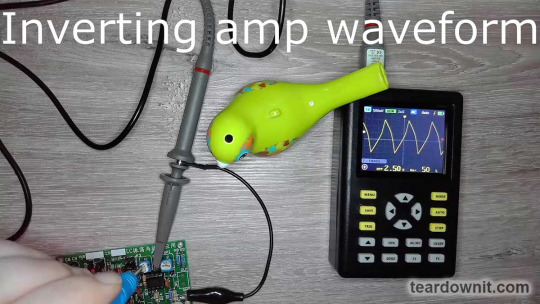
C6 and R7 are differentiator circuits or high-pass filters; their time constant is 1 millisecond. And the period of oscillations at a frequency of 133 kHz is 7.5 microseconds, which is 133 times less. Therefore, this RC chain has almost no effect on the signal flow at this frequency.
Where do the distortions come from, then? We haven't added a small ceramic capacitor parallel to RP1 to the circuit design. Several tens of picofarads of capacitance would've helped suppress the high-frequency resonance of the operational amplifier.
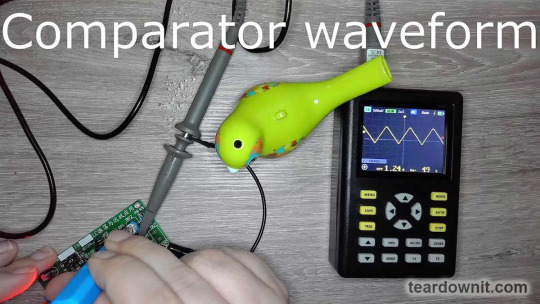
Finally, at the output of U2A, we see either a constant voltage or an almost perfect triangle wave, depending on the resistance of RP2. In the first case, U2A works as a comparator, and in the second, as an amplifier, thanks to the resistor R13 creating negative feedback.
The fact that the Colpitts oscillator frequency depends on the transistor base bias current was used in a small FM radio transmitter that I've assembled and tested. Experiments with it do not violate the laws on radio communications, as its power is extremely low. Transmitters like this are used in older cars to listen to music from a CD or MP3 player through an FM radio that does not have an AUX input.
Q1 amplifies the microphone signal, which then goes to the Q2 base, part of the Clapp oscillator. This is almost the same Colpitts generator, with an added capacitor C8 in series with the coil L4 to improve operating stability.
Q3 works as the output power amplifier. C7, C9, C10, and L3 together are the output filters for frequency matching with the antenna, which is just a piece of wire.
The input jack disconnects the Clapp oscillator from the microphone amplifier and supplies a modulating signal from an external source. For example, a homemade MP3 player, like in my video.
The left channel signal comes through resistor R10, and the right channel comes through resistor R7. This is a mono transmitter. I also plan to assemble a stereophonic modulator and tell you all about it in one of the upcoming posts.
youtube
0 notes
Text
Metal Enclosed Harmonic Filter Market Growth Analysis By Size, Share, News, Demand, Opportunity During 2035
Research Nester has released a report titled “Metal Enclosed Harmonic Filter Market–Global Demand Analysis & Opportunity Outlook 2035” which also includes some of the prominent market analyzing parameters such as industry growth drivers, restraints, supply and demand risk, market attractiveness, year-on-year (Y-O-Y) growth comparisons, market share comparisons, BPS analysis, SWOT analysis and Porter’s five force model.
Metal enclosed harmonic filters with various voltage ranges are increasingly being installed owing to the growing demand for electricity in the industrial sectors of the developing countries. There are numerous benefits of metal enclosed harmonic filters which is why it is preferred in industries. They improve the performance of the equipment and enhance the system's capacity in industries such as utility and commercial power systems and also eliminate electrical disturbances and harmonics. The growing demand for electricity in the industrial sectors of the developing countries is therefore anticipated to drive the growth of the metal enclosed harmonic filters market.
The global metal enclosed harmonic filter market is anticipated to achieve a CAGR of 10% across the globe over the forecast period, i.e. 2023-2035. Rising installations of harmonic filters in power distribution systems, growing industrialization in the developing countries worldwide, for instance the US, China, Australia, Germany, India, and various others, growing adoption of variable frequency drivers in the commercial and manufacturing industry, coupled with the numerous benefits associated with metal enclosed harmonic filters, such as reducing overall operating costs by efficient use power, reducing the risk of operational downtime from overloading, premature plant failure, and nuisance tripping among others. The global metal enclosed harmonic filter market registered a value of USD 631.78 million in the year 2019 and is anticipated to register an incremental $ opportunity of USD 32.85 million in the year 2020 as compared to the previous year and gain an absolute $ opportunity of USD 332.4 million by growing at 1.5x during the forecast period.
“The Final Report will cover the impact analysis of COVID-19 on this industry.”
Download/Request Sample Copy of Strategic Report: https://www.researchnester.com/sample-request-2689
Geographically, the global metal enclosed harmonic filter market is segmented into five major regions including North America, Latin America, Europe, Asia Pacific, Middle East and Africa. Among these regions, the market in Asia Pacific registered the largest market share of 47.49% in the year 2019 and is anticipated to gain an incremental $ opportunity of USD 16.36 million in the year 2020 as compared to the previous year and gain an absolute $ opportunity of USD 167.39 million by growing at 1.53x during the forecast period. Asia Pacific is growing as the global data center hub, which is requiring data center operators to deploy metal enclosed harmonic filters. Moreover, the increasing automotive industry in the nations such as China, India and others is also anticipated to drive the growth of the market in the region.
However, concerns for lack of awareness for metal enclosed harmonic filters among the small and medium enterprises is anticipated to limit the growth of the global metal enclosed harmonic filters market over the forecast period.
This report also studies existing competitive scenario of some of the key players of the global metal enclosed harmonic filters market, which includes profiling of ABB Ltd. (SWX: ABBN), Siemens AG (ETR: SIE), General Electric Company (NYSE: GE), CG Power and Industrial Solutions Limited (NSE: CGPOWER), Eaton Corporation plc (NYSE: ETN), Baron Power Limited, Northeast Power Systems, Inc., Arteche Group, Controllix Corporation, and AZZ Inc. (NYSE: AZZ).
Download Sample of This Strategic Report: https://www.researchnester.com/sample-request-2689
The profiling enfolds key information of the companies which comprises of business overview, products and services, key financials and recent news and developments. Conclusively, the report titled “Metal Enclosed Harmonic Filter Market – Global Demand Analysis & Opportunity Outlook 2035”, analyses the overall metal enclosed harmonic filters industry to help new entrants to understand the details of the market. In addition to that, this report also guides existing players looking for expansion and major investors looking for investment in the global metal enclosed harmonic filters market in the near future.
Browse Complete Summary of this report @
0 notes
Text
Metal Enclosed Harmonic Filter Market: Exploring the Latest Trends and Business Opportunities [2023-2035]
Research Nester has released a report titled “Metal Enclosed Harmonic Filter Market – Global Demand Analysis & Opportunity Outlook 2035” which also includes some of the prominent market analyzing parameters such as industry growth drivers, restraints, supply and demand risk, market attractiveness, year-on-year (Y-O-Y) growth comparisons, market share comparisons, BPS analysis, SWOT analysis and Porter’s five force model.
Metal enclosed harmonic filters with various voltage ranges are increasingly being installed owing to the growing demand for electricity in the industrial sectors of the developing countries. There are numerous benefits of metal enclosed harmonic filters which is why it is preferred in industries. They improve the performance of the equipment and enhance the system's capacity in industries such as utility and commercial power systems and also eliminate electrical disturbances and harmonics. The growing demand for electricity in the industrial sectors of the developing countries is therefore anticipated to drive the growth of the metal enclosed harmonic filters market.
The global metal enclosed harmonic filter market is anticipated to achieve a CAGR of 10% across the globe over the forecast period, i.e. 2023-2035. Rising installations of harmonic filters in power distribution systems, growing industrialization in the developing countries worldwide, for instance the US, China, Australia, Germany, India, and various others, growing adoption of variable frequency drivers in the commercial and manufacturing industry, coupled with the numerous benefits associated with metal enclosed harmonic filters, such as reducing overall operating costs by efficient use power, reducing the risk of operational downtime from overloading, premature plant failure, and nuisance tripping among others. The global metal enclosed harmonic filter market registered a value of USD 631.78 million in the year 2019 and is anticipated to register an incremental $ opportunity of USD 32.85 million in the year 2020 as compared to the previous year and gain an absolute $ opportunity of USD 332.4 million by growing at 1.5x during the forecast period.
“The Final Report will cover the impact analysis of COVID-19 on this industry.”
Get a Sample PDF Report Here:@ https://www.researchnester.com/sample-request-2689
Geographically, the global metal enclosed harmonic filter market is segmented into five major regions including North America, Latin America, Europe, Asia Pacific, Middle East and Africa. Among these regions, the market in Asia Pacific registered the largest market share of 47.49% in the year 2019 and is anticipated to gain an incremental $ opportunity of USD 16.36 million in the year 2020 as compared to the previous year and gain an absolute $ opportunity of USD 167.39 million by growing at 1.53x during the forecast period. Asia Pacific is growing as the global data center hub, which is requiring data center operators to deploy metal enclosed harmonic filters. Moreover, the increasing automotive industry in the nations such as China, India and others is also anticipated to drive the growth of the market in the region.
However, concerns for lack of awareness for metal enclosed harmonic filters among the small and medium enterprises is anticipated to limit the growth of the global metal enclosed harmonic filters market over the forecast period.
This report also studies existing competitive scenario of some of the key players of the global metal enclosed harmonic filters market, which includes profiling of ABB Ltd. (SWX: ABBN), Siemens AG (ETR: SIE), General Electric Company (NYSE: GE), CG Power and Industrial Solutions Limited (NSE: CGPOWER), Eaton Corporation plc (NYSE: ETN), Baron Power Limited, Northeast Power Systems, Inc., Arteche Group, Controllix Corporation, and AZZ Inc. (NYSE: AZZ).
The profiling enfolds key information of the companies which comprises of business overview, products and services, key financials and recent news and developments. Conclusively, the report titled “Metal Enclosed Harmonic Filter Market – Global Demand Analysis & Opportunity Outlook 2035”, analyses the overall metal enclosed harmonic filters industry to help new entrants to understand the details of the market. In addition to that, this report also guides existing players looking for expansion and major investors looking for investment in the global metal enclosed harmonic filters market in the near future.
About Research Nester
Research Nester is a leading service provider for strategic market research and consulting. We aim to provide unbiased, unparalleled market insights and industry analysis to help industries, conglomerates and executives to take wise decisions for their future marketing strategy, expansion and investment, etc. We believe every business can expand to its new horizon, provided a right guidance at a right time is available through strategic minds. Our out of box thinking helps our clients to take wise decision so as to avoid future uncertainties.
Contact Us:
AJ Daniel Email: [email protected] U.S. Phone: +1 646 586 9123 U.K. Phone: +44 203 608 5919
0 notes
Text


Original Characters - Heroes and Villains
Prologue:
This year is a special one for me, because this year makes a full decade for me as a creator, and also 5 years ago I started to make English-language webcomics named "Wardens" (who's later become the compass alliance). I'm thinking right now for stories to examine the new style, maybe I could take inspiration from early + iconic Marvel storylines (FF: the Galactus trilogy, X-men: night of the Sentinels, Avengers: under siege, thunderbolts vol. 1 and more...), because I also have my own villains: general darkness, time thief, the maestro, doctor monstro, and the grandmasters...
Image 1 - Heroes:
Started as an Idea for a new style that I come up with last week: less realistic and more cartoony and original, such as Tintin, Popeye, Hellboy, and Peanuts. In the upper side of the page we see from right to left: Paladin, Lady Astral, Voltage, and Dragon Fighter. In the bottom, we see the rest of the gang: Gigantic, Northlight, Symbol, Comrade, Nightlord, Melody, Enforcer, Rocket Prime, Technolad, Tsunami, Size, and Mariposa.
Image 2 - Villains:
The first time that I'm drawing my own team of supervillains after a long time. this page is inspired by one of the last pages of Thunderbolts issue 1 (Kurt Busiek and Mark Bagley), but instead of the masters of evil, I have villains of my own: The Grandmasters! The leader in the upper panel is called 'Q' (inspired by baron zemo and the Riddler), and under him, there is Bladejet (inspired by Deathstroke and the Beetle), the mad mechanic (mad hatter, the Fixer, and Doc Ock), Scylla (Aquaman's siren and moonstone), ultra-beef (goliath and abomination), & Icebite (iron man's blizzard and screaming Mimmi).
#comics#art#sketch#cartoon#superheroes#supervillains#comicbooks#digitlaillustration#heroes#villains#adventure#colors#digital drawing#clip studio art#idea#story ideas#creative#original
1 note
·
View note
Text





Gifs de la villanos que aparecen en uno de los clips de "The Hyper-Potamus Pizza-Party-Torium", que en realidad se tratan de simmax.
#big hero 6 the series#bh6#big hero 6#bh6 the series#the hyper potamus pizza party torium#momakase#mad jacks#baron von steamer#mr sparkles#mr. sparkles#high voltage#fred#fredzilla#frederick flamarion frederickson iv#go go tomago#simmax
60 notes
·
View notes
Note
i'm interested in these parallels and relations you find between bh6 series characters and comics characters. do you have any more ideas for those?
That’s not normally how this works. XD In all seriousness, I’ve sussed out these connections through a lot of episode watching and comics research. Given that there’s been no confirmation from anyone from the show (I’m looking at you, Bob, Mark, and Nick, because I know you’re reading this), the ideas tend to sprout up and latch on. The High Voltage/Dazzler theory was one that was completely out of thin air. I had been reminiscing about the time that Alison Blaire was in contention to be one of the heroes that was going to be a part of the beta team, but got cut early on. And then I started actually looking at them:


And then one thing just leads to another. Alison’s mom changing her name to Barbara to start a new life was an ironic twist in the mix. Throughout all of the Marvel/Big Hero 6 crossover characters, there’s actually one that I haven’t even mentioned that is completely obvious, and it involves Boss Awesome’s most famous nemesis, Baron Von Steamer.

Whom is actually based off of one of Captain America’s oldest villains...Baron von Strucker.

Like...they didn’t even change the names that much. So I guess I gave you one right there. I’m sure there are others that I haven’t even thought of yet, and there’s also ones that I’m looking that are harder to figure out.
I’m looking at you, Pink-Haired Biker Chick Girl.
#big hero 6#big hero 6 the series#marvel comics#marvel#alison blaire#dazzler#high voltage#boss awesome#baron von steamer#baron von strucker#crossover potential
1 note
·
View note
Text
He can see it in his nictitating membrane. That fiber slip of skin tacitly Ren's, because Feyd-Rautha didn't know, before. Because it was sleeping.
In a sac, or a womb; they smell of prebirth. Kneeling, wondering, is like being stroked in the baby-soft hollow of his head.
He should choke. Hands like its, black and teething, drawbridge at the drape of a tongueless scowl, it would be like a first time. Feyd-Rautha hasn't been vestal like this since infancy.
So he's watching slender hands like the wind finger a dirge in deep along his sockets, so he's seeping out the way of the witches' embryonic stew. Slack in the spine and an emperor in the genome. He smiles, mad, at the boot-in of a wire crossing somewhere—a secret name—across the psychosomatic way, a tear in a fold in a secret in a cousin. I see you. Oh, does he need to. I do see you.
‘ Would you like to see their hands? ’ They don't always want what they want, and they never mean what they mean. ‘ Would you like to kiss one? ’
The Bene Gesserit didn't want this war until they had to. Feyd, he wants it like the cure and the disease.
He wants it like the tracts of Giedi belly out their Harkonnen battle hymns and drum the jaundiced skin of the weak over marrow of the old, over old teeth, and pretend their whites up cooked, ready, more solid than Sisterhood sinew. The na-Baron's throat exposes vascular cords for some other machina, neither end nor mean. He wants in an opposite direction. He wants because he can, because they are here, because he's curious. He wants to be turned out raw.
Lets him blink. He doesn't. Their blood song floats on his sandpaper, his throat. He becomes, too, in laughter
a boy. a sliver pyramiding between ancient meats' voltage. a tongue homing for the head of theren he'd see tailed. an arm and a hand feyd-rautha washes up dead around theren's metal scruff for a feeling-his-way-in handhold, in upon their aperture, in-between their pain. he's their thumbnail. he snags and bleeds.
dowwnnnn. closer. his white fingers pad-pad ren's exoskull.
‘ How do you die, big dog. How do I make you. ’
he already kneels.
this is pledging.
Ren approaches, sweeps daylight's thin gauze like a shadow stretching under a strong sun, and the umbraged chaos of voices trails the fertile vessels in Feyd-Rautha's external jugular, sliding their talons down his throat. Want, want, want. He should choke.
The helm, black totem, moves with slight undulation, close enough to brush Feyd's nose. His shadow voice prods his mind's eye's filmy lid.
the Ren, it whispers, 'how?'—the Ren, in the marrow, in the Force that joins all life, and outside the Force that shatters that very same life, bursts, slick with unbirth, and burgeons beyond what is dark and light, flowing steadily forward into Giedi Prime; is that love?
And the chaos of voices bleeds through:
—Ha! Let us nose these great pledges while the body's still warm.
—Show us, 'na-Baron,' show us your empty head.
—♱Give us your eye, and we shall hold it gently.♱
Some other sinuous claw rakes Feyd's trachea, an extension of the Ren's body pressing through his mouth's roof and into the skull that would cave as he might, holding his eyes in its pincers. Eyes that have seen details without registering their every inverse mirror, for the na-Baron has been meddled with sometime not long ago. A shame... and an opening. Black and wet as Feyd-Rautha's locked muzzle.
He rolls in pleasure-pain like a dog, and Ren's young warriors buck against him, with voices, with eidolon teasings of bandorium or kyber. Sensory memories to put to death.
Ren's slick of this pain, sight-focused. Physically tyrannical but almost bodiless of the animating principle that drives men, but he's dogged for answers; he wears a mask.
"They promise hands in the design of war?" Feyd-Rautha's eyes blear in Ren's helm. "No. They strive for more."
Put a muzzle on the cosmos; another order. The First Order hasn't yet arrived, and so the Ren sinks its fangs in first, flowing forward into the crude oblong slices of Giedi Prime's blood cities, a new nature, living metals, skulls that don't cave.
Change is a slow groan:
We are hands. We are a heart, a body that yields a knife, dagger, or mirror. A body that never repeats itself, that flows forward, that gives life, and takes life. A swelling black river who all that touch it will drown within and become. That is no pledge. That is a certainty.
The boy's pale flesh will learn the voices, the anatomy.
"The Bene contrive. We become." Ren gestures with glove-sheathed hand to Giedi Prime's iron ranges, the beaded webs between galaxies, and the blood he has earned rattles their osseous death song softly, just once, as Ren lowers his arm. He still has flesh to filch. "I pledge nothing to you. You—"
Ren's claw holds Feyd-Rautha, keeps his blood warm. Lets him blink.
You'll be the one to pledge. The one to kneel.
And he releases him, wondering only if the Harkonnen pillar will topple or become a blade.
@nightmarefuele
4 notes
·
View notes
Photo








#Stamps#Lego Racers#LR Rocket Racer#Veronica Voltage#rocket racer#sam sinister#baron von baron#Johnny Thunder#Basil the Batlord#captain redbeard#navigator sharp#LEGO Rocket Racer#LEGO Johnny Thunder
26 notes
·
View notes
Text

I look back on this scene and keep hoping for a Xendalia Route. At this point I’m not sure that it will ever happen but I can still be optimistic!
#dr xendalia#sp xendalia#lvstrck#lovestruck voltage#lovestruck#xendalia#dr. xendalia#starship promise#starship promise xendalia#xendaliaroute#givexendaliaaroute#baron von slugenstein#lovestruck app
12 notes
·
View notes
Text
Have a rare meme from me before school eats me lol

#big hero six the series#bh6 the series#big hero 6#bh6#here goes the text spam of every villain i have to tag#bh6 mr sparkles#bh6 momakase#bh6 obake#bh6 chris#bh6 globby#bh6 nega globby#bh6 el fuego#bh6 nbb#bh6 noodle burger boy#bh6 baron von steamer#bh6 supersonic sue#bh6 mad jacks#bh6 high voltage#bh6 juniper#bh6 barb#bh6 yama#bh6 miniyama#bh6 liv amara#bh6 trina#phew#that should be it#meme
83 notes
·
View notes
Video
tumblr
We’ve got a big storm coming :)))
I’ve wanted to edit on this audio for a while now! (audio credits to @hinaudios on Instagram)
CLICK HD FOR BETTER QUALITY
#YOU GUYS THIS SHORT VIDEO TOOK ALMOST 4 HOURS TO RENDER PLZ REBLOG#i'm sorry for plottwisting obake iauyfauebfa#amv#edit#my edits#vid#big hero 6#bh6#big hero six#big hero 6 the series#bh6 the series#big hero 6 the series spoilers#bh6 the series spoilers#liv amara#obake#yama#high voltage#baron von steamer#momakase#mad jacks#mr sparkles#noodle burger boy
75 notes
·
View notes
Text
Global Metal Enclosed Harmonic Filter Market Size, CAGR, Growth & Forecast To 2035
Research Nester has released a report titled “Metal Enclosed Harmonic Filter Market – Global Demand Analysis & Opportunity Outlook 2035” which also includes some of the prominent market analyzing parameters such as industry growth drivers, restraints, supply and demand risk, market attractiveness, year-on-year (Y-O-Y) growth comparisons, market share comparisons, BPS analysis, SWOT analysis and Porter’s five force model.
Metal enclosed harmonic filters with various voltage ranges are increasingly being installed owing to the growing demand for electricity in the industrial sectors of the developing countries. There are numerous benefits of metal enclosed harmonic filters which is why it is preferred in industries. They improve the performance of the equipment and enhance the system's capacity in industries such as utility and commercial power systems and also eliminate electrical disturbances and harmonics. The growing demand for electricity in the industrial sectors of the developing countries is therefore anticipated to drive the growth of the metal enclosed harmonic filters market.
The global metal enclosed harmonic filter market is anticipated to achieve a CAGR of 10% across the globe over the forecast period, i.e. 2023-2035. Rising installations of harmonic filters in power distribution systems, growing industrialization in the developing countries worldwide, for instance the US, China, Australia, Germany, India, and various others, growing adoption of variable frequency drivers in the commercial and manufacturing industry, coupled with the numerous benefits associated with metal enclosed harmonic filters, such as reducing overall operating costs by efficient use power, reducing the risk of operational downtime from overloading, premature plant failure, and nuisance tripping among others. The global metal enclosed harmonic filter market registered a value of USD 631.78 million in the year 2019 and is anticipated to register an incremental $ opportunity of USD 32.85 million in the year 2020 as compared to the previous year and gain an absolute $ opportunity of USD 332.4 million by growing at 1.5x during the forecast period.
“The Final Report will cover the impact analysis of COVID-19 on this industry.”
Download/Request Sample Copy of Strategic Report: https://www.researchnester.com/sample-request-2689
Geographically, the global metal enclosed harmonic filter market is segmented into five major regions including North America, Latin America, Europe, Asia Pacific, Middle East and Africa. Among these regions, the market in Asia Pacific registered the largest market share of 47.49% in the year 2019 and is anticipated to gain an incremental $ opportunity of USD 16.36 million in the year 2020 as compared to the previous year and gain an absolute $ opportunity of USD 167.39 million by growing at 1.53x during the forecast period. Asia Pacific is growing as the global data center hub, which is requiring data center operators to deploy metal enclosed harmonic filters. Moreover, the increasing automotive industry in the nations such as China, India and others is also anticipated to drive the growth of the market in the region.
However, concerns for lack of awareness for metal enclosed harmonic filters among the small and medium enterprises is anticipated to limit the growth of the global metal enclosed harmonic filters market over the forecast period.
This report also studies existing competitive scenario of some of the key players of the global metal enclosed harmonic filters market, which includes profiling of ABB Ltd. (SWX: ABBN), Siemens AG (ETR: SIE), General Electric Company (NYSE: GE), CG Power and Industrial Solutions Limited (NSE: CGPOWER), Eaton Corporation plc (NYSE: ETN), Baron Power Limited, Northeast Power Systems, Inc., Arteche Group, Controllix Corporation, and AZZ Inc. (NYSE: AZZ).
The profiling enfolds key information of the companies which comprises of business overview, products and services, key financials and recent news and developments. Conclusively, the report titled “Metal Enclosed Harmonic Filter Market – Global Demand Analysis & Opportunity Outlook 2035”, analyses the overall metal enclosed harmonic filters industry to help new entrants to understand the details of the market. In addition to that, this report also guides existing players looking for expansion and major investors looking for investment in the global metal enclosed harmonic filters market in the near future.
About Research Nester
Research Nester is a leading service provider for strategic market research and consulting. We aim to provide unbiased, unparalleled market insights and industry analysis to help industries, conglomerates and executives to take wise decisions for their future marketing strategy, expansion and investment, etc. We believe every business can expand to its new horizon, provided a right guidance at a right time is available through strategic minds. Our out of box thinking helps our clients to take wise decision so as to avoid future uncertainties.
Contact Us:
AJ Daniel
Email: [email protected]
U.S. Phone: +1 646 586 9123
U.K. Phone: +44 203 608 5919

1 note
·
View note